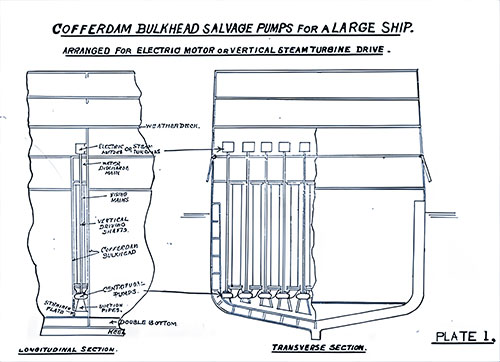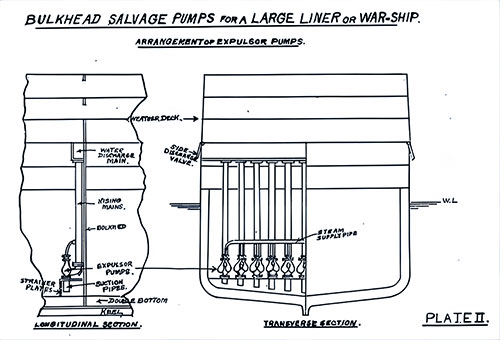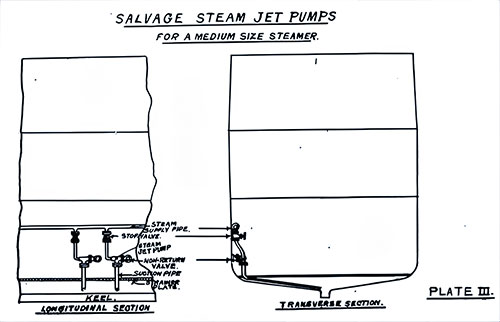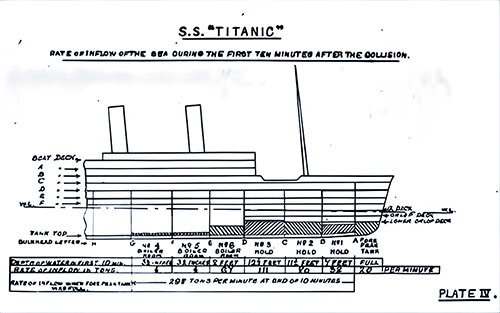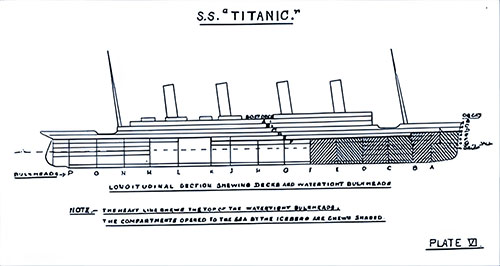Titanic’s Sinking Reexamined: Engineering Flaws, Pumping Systems, and Salvage Solutions (1915)
📌 Published three years after the Titanic disaster, How to Save a Big Ship from Sinking (1915) explores alternative solutions that could have kept the Titanic afloat. This collection of rare diagrams and technical insights is essential for maritime historians, engineers, and students studying Titanic’s engineering failures.
Titanic Images - How to Save a Big Ship from Sinking (1915) 🚢⚙️🚨
Introduction: A Groundbreaking Perspective on Maritime Safety
Written just three years after the Titanic disaster, How to Save a Big Ship from Sinking (1915) by Charles V. A. Eley presents a compelling analysis of ship safety, emergency protocols, and technical improvements that could prevent future maritime disasters. Unlike earlier Titanic reports focused on human error and lifeboat capacity, this book delves into the engineering flaws that led to the rapid sinking of the Titanic and proposes practical solutions to improve ship stability, water pumping efficiency, and emergency response.
For teachers, students, maritime historians, engineers, and genealogists, this technical yet accessible work offers valuable insight into the lessons learned from the Titanic and how they shaped the future of ocean travel. The detailed diagrams, editorial reviews, and expert opinions make it an indispensable primary source for research and educational projects.
Many vessels flounder had insufficient pumping machinery on board to deal with the incoming water due to the ship straining in a storm.
In other cases, I believe vessels founder through want of knowledge on the part of the engine, either through only having just joined their ship or through not having studied the question of balancing their vessel and forming a proper course as to how to act in cases of emergency in the matter of closing or opening communicating doors of watertight compartments.
In other cases, vessels have been lost which had on board sufficient power in their auxiliary pumps to save the ship, but owing to the lousy arrangement of same, one couldn't use them. In later chapters, I will deal with these matters more minutely and endeavor to state some actual cases.
Charles V. A. Eley. How to Save a Big Ship from Sinking, Even Though Torpedoed, London: Simkin, Marshall, Hamilton, Kent & Co., Ltd., (1915).
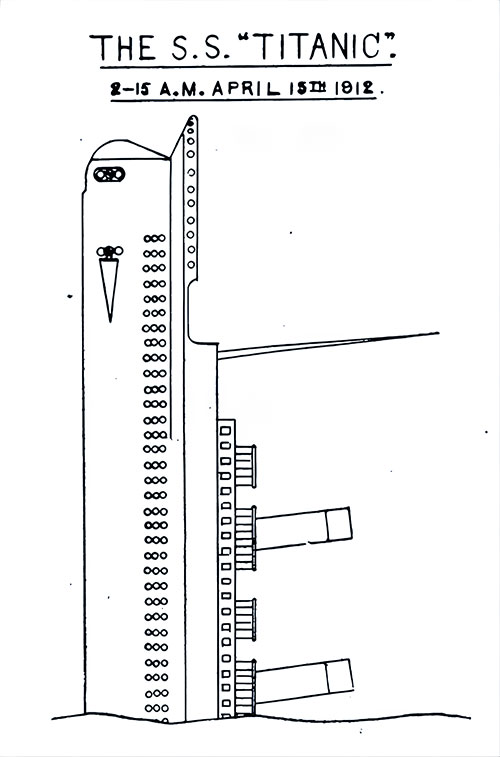
The S.S. Titanic, 2:15 am, 15 April 1912 (Frontispiece). And She Did Eventually Attain the Perpendicular. How to Save a Big Ship from Sinking, 1915. | GGA Image ID # 10a2d3d49b
Plate 1: Cofferdam Bulkhead Salvage Pumps for a Large Ship. Arranged for Electric Motor or Vertical Steam Turbine Drive. Longitudinal Secion on Left; Transverse Section shown on Right. How to Save a Big Ship from Sinking, 1915. | GGA Image ID # 10e998eb91. Click to View a Larger Image.
Plate 2: Bulkhead Salvage Pumps for a Large Liner or War Ship. Arrangement of Expulsor Pumps. Longitudinal Secion on Left; Transverse Section shown on Right. How to Save a Big Ship from Sinking, 1915. | GGA Image ID # 10e9d45a81. Click to View a Larger Image.
Plate 3: Salvage Steam Jet Pumps for a Medium Size Steamer. Longitudinal Secion on Left; Transverse Section shown on Right. How to Save a Big Ship from Sinking, 1915. | GGA Image ID # 10e9efc425. Click to View a Larger Image.
SS Titanic: Rate of Inflow of the Sea During the First Ten Minutes After the Collision. How to Save a Big Ship from Sinking, 1915. | GGA Image ID # 10a2d67377. Click to View a Larger Image.
SS Titanic - Longitudinal Section Showing Decks and Watertight Bulkheads. How to Save a Big Ship from Sinking, 1915. | GGA Image ID # 10a2deecbc. Click to View a Larger Image.
How to Keep a Damaged Ship Afloat (Editorial Review)
To the Editors of Engineering Magazine
Sir,—In your issues of ENGINEERING dated November 10 and 26 you print letters on "Compressed Air for the Salving of Battleships" and "How to Keep a Damaged Ship Afloat" respectively. As I cannot agree with the views of Mr. Brunton, the writer of the last- mentioned letter, I will be glad if you will kindly give the same publicity to the following —
Mr. Brunton stated : "Assuming that the ship is damaged forward, there are three methods whereby the bows can be prevented from sinking." I think the words might be should have been used, as I believe it would he very risky for s shipowner or our Admirably to trust to either the first or third methods mentioned by Mr. Brunton, whilst the second method, which Mr. Brunton deprecates the use of, is, in my opinion, the very best system the I (shipowner) could adopt.
Let us review the systems in the order given by Mr. Brunton
First System. The admission of compressed air into the damaged compartments, etc.—I agree with both writers that such plan could not be serviceably used, because with any perforation high up in the flooded compartment the air would encape instead of forcing out the water.
Second System. The pumping of the water out of the compartment as fast as it enters, thereby limiting the amount of a water in the ship.—This method is, in my opinion, the safest to adopt, because not only is pumping machinery of today almost immune from breakdown over long I periods of time, but also because the greater part of the sbíp and its contents could be kept dry, and the vessel in most instances would not be suffering from either " heel” or “ trim."
Take the case of the Titanic, mentioned by Mr. Brunton, as an example. If Lord Mersey’s report on the loss of the vessel is carefully read, it will be seen that the water entered through the damage at a rate of about 300 tons per minute; and if 30-in. suction-pipes had been provided into the bilge from each of the 29-in. centrifugal circulating pumps, and the water tight doors in the heads bad been left open, or means provided for passing the water through the double bottom to the pump suctions, such pumps could have put the whole of the water overboard as fast as it entered, and they would only have been doing their ordinary daily work. Further, if the four electric lighting engines bad been arranged with four 50 in. centrifugal pumps, these, with the circulating pumps, could have put overboard four times the quantity of water entering the Titanic, without having to close a water-tight door in the ship.
Electric pumps might have boon provided if preferred. With pumps of either type no difficulty would arise, in my opinion, in getting the vessel into port from the middle of the Atlantic, In fact, as the damaged compartments would have been open for inspection, meet of the damage could probably have been closed. This established a good case in favor of pumping, and I could give many other examples dealing with other kinds of damage, if necessary.
Third System. The pumping of water into the stern to create a head which would have the effect of forcing the stern down and lifting the bow.—This system is, in my opinion, very little better than system No. 1, owing to its narrow range of usefulness.
I agree with Mr. Brunton, “ that any water shove the damaged part of the ship should not be reckoned as ! weight.” But it must not be forgotten that the whole of the compartments open to the sea have lost buoyancy,” and such part of the ship will have to be supported by the sound pert of the vessel.
In some types of damage this ices of buoyancy must be so extensive as to prevent salving ship by such a system.
Let us look well into an exact case again, say, the Titanic, as it will compare with what I have written under system 2, and will also keep to the case named by
Mr. Brunton.
I reproduce s drawing of the Titanic from Lord Mersey’s report. The vessel’s length was 832 1/2 feet the beam 92 1/2 ft., and the weather deck 64 feet above the keel amidships. The displacement Was 52,310 tons at 34 feet 7 inches draught. Assuming that the immersed length of the vessel, say, 825 ft., was constant, and the 34 feet 7inch draught was equal throughout its length, the average breadth of the parallelopipedon would be 6 Feet.
Therefore, at the time the Titanic struck the iceberg, as the draught was 32 feet only, the displacement would be about 48,000 tons. When the loss of buoyancy occurred to 304 feet of the vessel forward, the remaining 521 ft. had to carry the whole of the 48,000 tons; and assuming an even keel, the draught would be increased to 48 ft, without reckoning anything for weight of water in the ship below the damage.
Then, if water was pumped into compartments aft, to balance the loss of buoyancy and the 2000 tons of water in the forward compartments below the damage, the four aftermost compartments would have to be filled up to the tops of the watertight bulkheads. By careful calculation I find that, allowing 20 percent, for fittings, cargo, stores, machinery, etc., there would be 15,828 tons of water in such four compartments, and that it would just about balance the turning moment forward.
It would, however, have put the keel down to 64 feet draught on an even keel, and the water would then have been 17 ft above the line of reserve buoyancy; therefore the vessel could not have been saved.
In conclusion, I thank you for the notice which you have given, under ‘‘Books Received,” in your issue of November 2, of my book, " How to Save & Big Ship from Sinking,” in which your readers who are interested in this subject will find much more about the Titanic and other ships.
Yours faithfully,
Charles V. A. Elet,
10, Cambridge crescent, Edgbaston, Birmingham,
December 11, 1915.
"How to Keep a Damaged Ship Afloat," in Engineering: An Illustrated Weekly Journal, London: Bedford Press, 17 December 1915, Vol. C, p. 624.
Key Highlights and Most Engaging Content
1️⃣ Titanic’s Final Moments: The Perpendicular Descent 🕰️⚓
One of the most striking images in this collection captures the Titanic’s final moments at 2:15 AM on April 15, 1912, as the stern rose dramatically into the air before the ship plunged into the Atlantic.
🔹 Noteworthy Image: The S.S. Titanic, 2:15 AM, April 15, 1912 – And She Did Eventually Attain the Perpendicular
📌 Significance: This haunting image confirms eyewitness reports that the Titanic’s stern lifted almost vertically before the final descent. It visually reinforces the critical failures in the ship’s watertight compartment system.
🔹 Historical Connection: The break-up theory was controversial until Dr. Robert Ballard’s 1985 discovery of the Titanic wreck confirmed that the ship had split in two.
This image remains one of the earliest attempts to illustrate the Titanic’s true demise.
2️⃣ The Problem of Flooding: Could the Titanic Have Been Saved? 💦🚢
A central theme of Eley’s book is whether the Titanic could have stayed afloat longer—or even reached port—if better pumping systems had been in place. The book debunks the myth that the ship was doomed from the moment of impact and explores potential alternative survival strategies.
🔹 Noteworthy Image: SS Titanic – Rate of Inflow of the Sea During the First Ten Minutes After the Collision
📌 Significance: This diagram quantifies the immense flooding rate, showing how water poured into the ship at an uncontrollable speed—but also suggests that if the right pumping infrastructure had existed, the ship might have stayed afloat longer.
🔹 Noteworthy Image: SS Titanic - Longitudinal Section Showing Decks and Watertight Bulkheads
📌 Significance: This cross-section of Titanic’s interior layout is critical for understanding why the ship sank so quickly. It illustrates that the ship’s bulkheads did not extend high enough, allowing water to spill over into undamaged compartments.
3️⃣ The Engineering Solutions That Could Have Saved Titanic 🛠️⚙️
Eley’s book outlines three methods for keeping a damaged ship afloat, analyzing their effectiveness and practicality. His engineering-first approach offers a fascinating contrast to the blame-focused narratives that dominated early Titanic discussions.
🔹 Noteworthy Image: Cofferdam Bulkhead Salvage Pumps for a Large Ship
📌 Significance: This detailed technical drawing showcases a potentially life-saving innovation—a bulkhead salvage pump system that could have pumped water out of the Titanic at the same rate it was flooding.
🔹 Noteworthy Image: Bulkhead Salvage Pumps for a Large Liner or Warship
📌 Significance: This illustrates how large-scale pump systems could have been arranged within ocean liners and military ships to prevent sinking, offering insights into naval safety advancements following the Titanic disaster.
🔹 Noteworthy Image: Salvage Steam Jet Pumps for a Medium-Sized Steamer
📌 Significance: This technology could have redirected incoming water to allow damaged ships to maintain buoyancy—an innovation that became more common in later 20th-century ocean liners.
4️⃣ The Debate Over Ship Stability: A Controversial Editorial Review 🗞️🧐
One of the most unique aspects of this collection is an editorial review of the book, published in Engineering Magazine (1915), where experts debated the best way to stabilize a sinking ship.
🔹 Key Discussion Points from the Review:
Could compressed air have been used to keep Titanic afloat? 🤔
Would larger suction pumps have been able to expel water fast enough? 💦
Was pumping water into the stern to balance the weight a viable solution? ⚖️
📌 Significance: This review highlights the divergence in expert opinions on how to prevent ships from sinking—a debate that led to major improvements in ship design and safety regulations after the Titanic.
Relevance for Teachers, Students, Historians, and Genealogists
👩🏫 Teachers & Students:
🔹 Ideal for STEM lessons on maritime engineering and disaster prevention.
🔹 Encourages students to analyze historical problem-solving methods and propose modern solutions.
🔹 Provides primary sources for essays on ship safety, engineering, and Titanic’s lasting impact.
📜 Historians & Maritime Enthusiasts:
🔹 Offers a rare technical perspective on the Titanic disaster.
🔹 Includes valuable engineering diagrams that reveal how ship safety evolved post-1912.
🔹 Highlights the transformation of maritime regulations in response to Titanic’s sinking.
🧬 Genealogists & Family Historians:
🔹 Helps descendants of Titanic passengers understand why the ship was lost so quickly.
🔹 Provides insight into the ship’s structural failures, offering a deeper appreciation of the tragedy.
Encouragement for Students: Essay & Research Topics
💡 Looking for an Essay Idea?
🔹 Could advanced pumping systems have saved the Titanic?
🔹 What role did bulkheads play in the Titanic’s sinking?
🔹 How did engineering debates after the Titanic lead to improved ship safety?
🔹 Was Titanic’s sinking inevitable, or could better emergency protocols have made a difference?
🚢 The Titanic’s story isn’t just about a shipwreck—it’s about the evolution of maritime safety and engineering. This book proves that even after disaster strikes, innovation and progress can emerge. 🌊⚓

